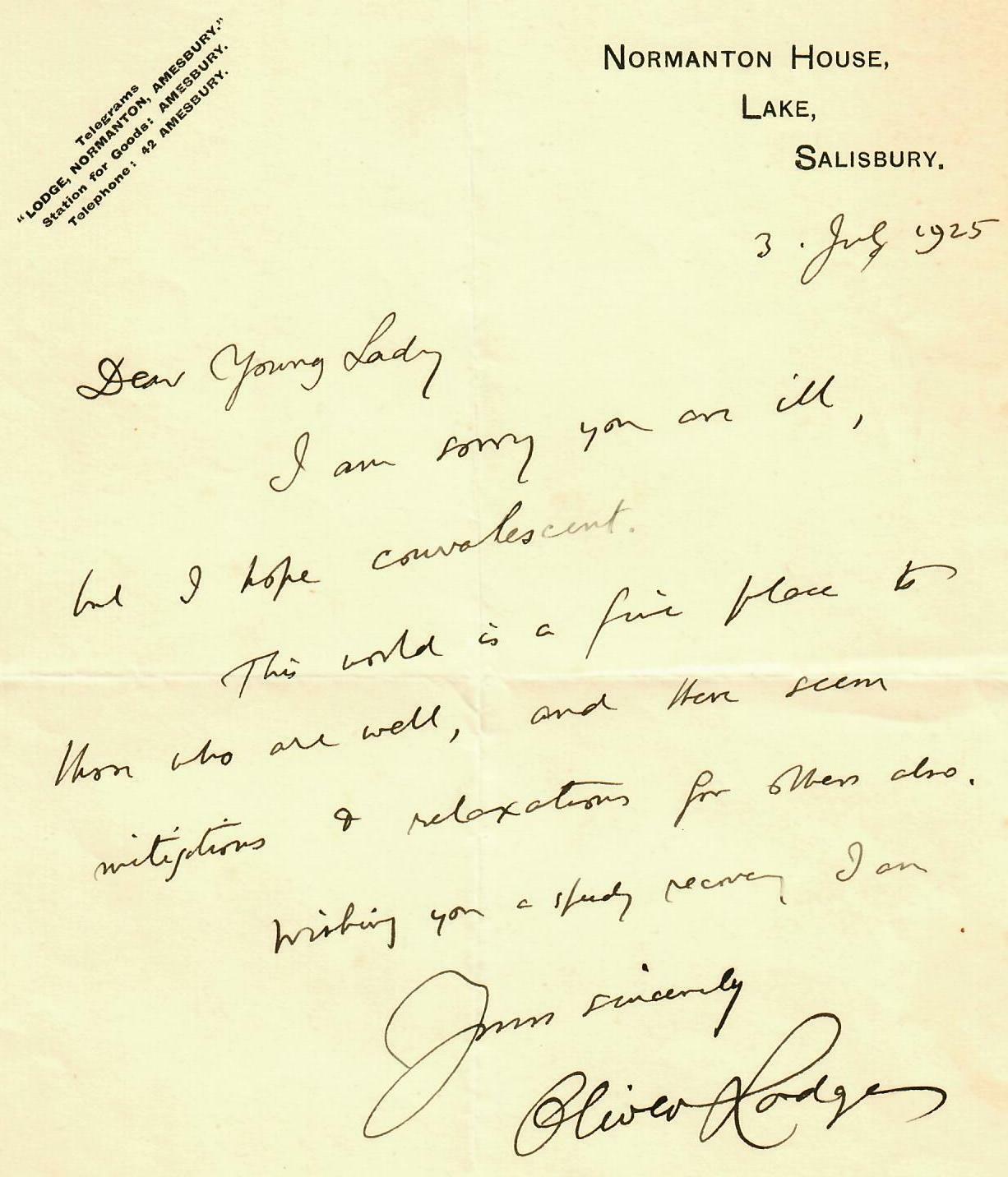"Electromagnatic Radiation" Oliver Lodge Hand Written Letter From 1925 COA For Sale

When you click on links to various merchants on this site and make a purchase, this can result in this site earning a commission. Affiliate programs and affiliations include, but are not limited to, the eBay Partner Network.
"Electromagnatic Radiation" Oliver Lodge Hand Written Letter From 1925 COA:
$209.99
Official PayPal Conversion Rates Add Currency Converter To Your Items ES - 1978
Sir Oliver Joseph Lodge, FRS[1] (12 June 1851 – 22 August 1940) was a British physicist and writer involved in the development of, and holder of key patents for, radio. He identified electromagnetic radiation independent of Hertz's proof and at his 1894 Royal Institution lectures ("The Work of Hertz and Some of His Successors"), Lodge demonstrated an early radio wave detector he named the "coherer". In 1898 he was awarded the "syntonic" (or tuning) patent by the United States Patent Office. Lodge was Principal of the University of Birmingham from 1900 to 1920. Oliver Lodge was born in 1851 at 'The Views', Penkhull, then a rural village high above the emerging Potteries of North Staffordshire in what is now Stoke-on-Trent, and educated at Adams' Grammar School, Newport, Shropshire. His parents were Oliver Lodge (1826–1884) – later a ball clay merchant[1] at Wolstanton, Staffordshire – and his wife, Grace, née Heath (1826–1879). Lodge was their first child, and altogether they had eight sons and a daughter. Lodge's siblings included Sir Richard Lodge (1855–1936), historian; Eleanor Constance Lodge (1869–1936), historian and principal of Westfield College, London; and Alfred Lodge (1854–1937), mathematician. When Lodge was 12, the family moved house a short distance north along the valley ridge, to Wolstanton. There, at Moreton House on the southern tip of Wolstanton Marsh, he took over a large outbuilding for his first scientific experiments during the long school holidays. In 1865, Lodge, at the age of 14, left his schooling and entered his father's business (Oliver Lodge & Son) as an agent for B. Fayle & Co selling Purbeck blue clay to the pottery manufacturers. This work sometimes entailed him travelling as far as Scotland. He continued to assist his father until he reached the age of 22. His father's growing wealth from trade enabled him to move the family to Chatterley House, Hanley, when Lodge was 18. From there Lodge attended physics lectures in London, and also attended the Wedgwood Institute in nearby Burslem. At Chatterley House, just a mile south of Etruria Hall where Wedgwood had experimented, Lodge's Autobiography recalled that "something like real experimentation" began for him around 1869. Growing increasingly affluent in a booming industrial economy, the family moved again in 1875 – this time to the nearby Watlands Hall at the top of Porthill Bank between Middleport and Wolstanton (demolished 1951). Lodge obtained a Bachelor of Science degree from the University of London in 1875 and gained the title of Doctor of Science in 1877. At Wolstanton he experimented with producing a wholly new "electromagnetic light" in 1879 and 1880, paving the way for later experimental success. During this time, he also lectured at Bedford College, London. Lodge left the Potteries district in 1881, to take the post of Professor of Physics and Mathematics at the newly founded University College, Liverpool. In 1900 Lodge moved from Liverpool back to the Midlands and became the first principal of the new Birmingham University, remaining there until his retirement in 1919. He oversaw the start of the move of the university from Edmund Street in the city centre to its present Edgbaston campus. Lodge was awarded the Rumford Medal of the Royal Society in 1898, and was knighted in the 1902 Coronation Honours, receiving the accolade from King Edward VII at Buckingham Palace on 24 October that year.[6] In 1928 he was made Freeman of his native city, Stoke-on-Trent. Lodge married Mary Fanny Alexander Marshall at St George's Church, Newcastle-under-Lyme in 1877. They had twelve children, six boys and six girls: Oliver William Foster (1878–1955), Francis Brodie (1880–1967), Alec (1881–1938), Lionel (1883–1948), Noel (1885–1962), Violet (1888–1924), Raymond (1889–1915), Honor (1891–1979), Lorna (1892–1987), Norah (1894–1990), Barbara (1896–1983), and Rosalynde (1896–1983). Four of his sons went into business using Lodge's inventions. Brodie and Alec created the Lodge Plug Company, which manufactured spark plugs for cars and aeroplanes. Lionel and Noel founded a company that produced an electrostatic device for cleaning factory and smelter smoke in 1913, called the Lodge Fume Deposit Company Limited (changed in 1919 to Lodge Fume Company Limited and in 1922, through agreement with the International Precipitation Corporation of California, to Lodge Cottrell Ltd). Oliver, the eldest son, became a poet and author. After his retirement in 1920, Lodge and his wife settled in Normanton House, near Lake in Wiltshire, a few miles from Stonehenge. Lodge and his wife are buried at the local parish church, St. Michael's, Wilsford cum Lake.[7] Their eldest son Oliver and eldest daughter Violet are buried at the same church.

Related Items:
"Electromagnatic Radiation" Oliver Lodge Hand Written Letter From 1925 COA
$209.99

